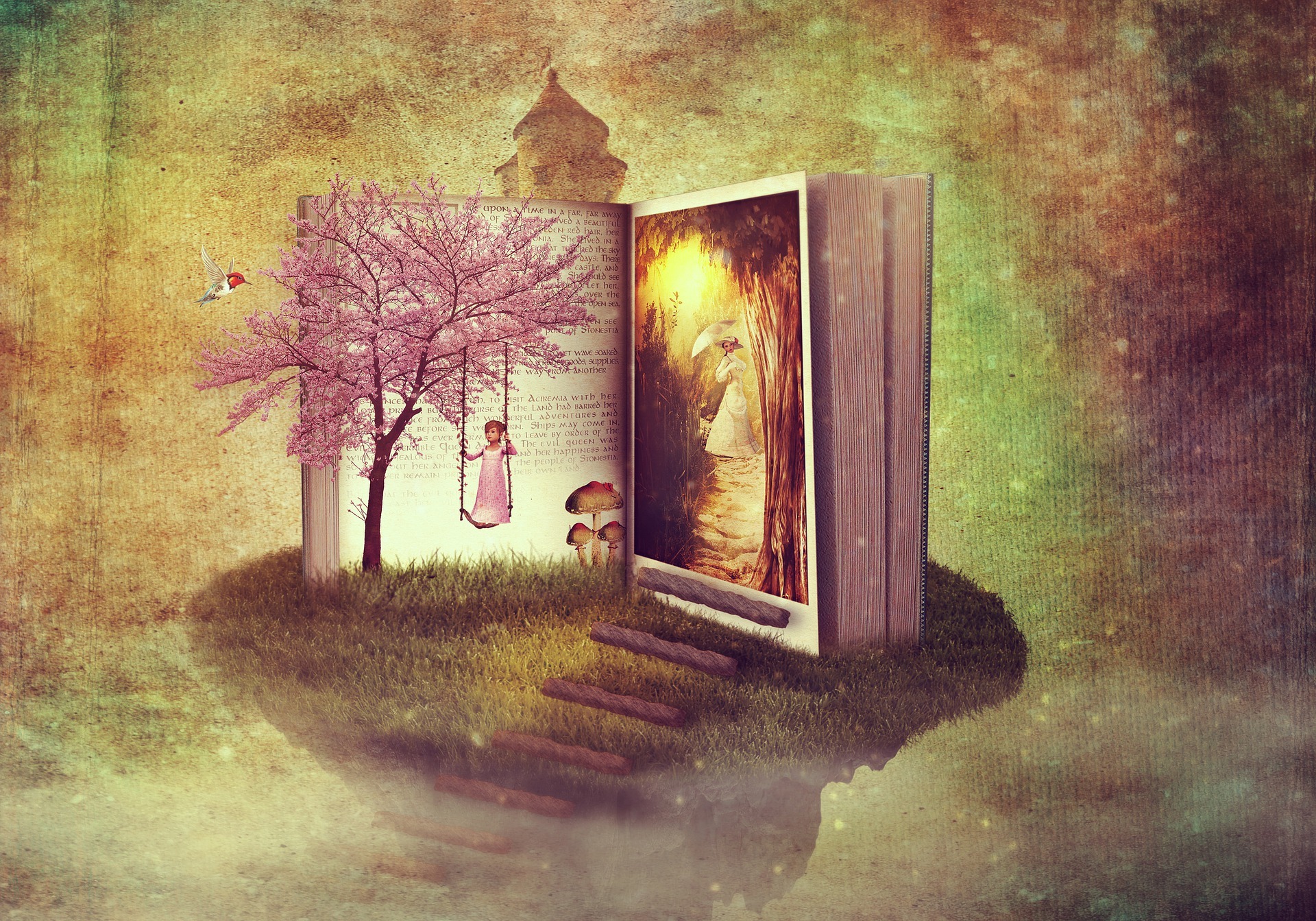
In Little Red Riding Hood, a naive girl ends up in the belly of a wolf. In The Handless Maiden, a father makes a deal with the devil and must cut off his daughter’s hands. In The Pied Piper, a mysterious musician leads an entire village of children to death by drowning. Why do we relish horrifying tales where jealous mothers kill their children and little girls dance themselves to death? Because the darkness in stories can help us confront the darkness inside ourselves. Fantasy offers what author Ursula K. Le Guin called “an alternative technique for apprehending and coping with existence,” a surrealism that highlights the real world and our experiences in it. Helen Oyeyemi, whose novels build upon the skeletons of ancient stories, explained, “I write and retell fairy tales because I’m convinced they are real, that they are talking about our lives as we live them. Not idealized or fantastic. They are talking about truths that we sometimes want to look away from.”
These truths can be dark, grotesque, and shameful, but that’s the point. Even if we can’t pinpoint exactly why a story like Hansel & Gretel resonates with us, we understand it at a core level. For some, it might be the parental abandonment (physical or psychological), for others, it might be the gingerbread house – the ultimate honeytrap — or even the witch herself: that part of ourselves that keeps our creativity, intelligence, or curiosity locked away in a cage.
As a child growing up in a fundamentalist Christian community, I wasn’t allowed to read fantasy novels. Magic was too close to witchcraft, which was too close to the devil. Somehow, though, a handful of fantastical stories slipped through: an old, falling-apart copy of a collection of fairytales escaped parental censorship, and I devoured its contents repeatedly. In a household where television was banned and any film with more than a PG rating forbidden, the one Disney film that miraculously passed inspection was Beauty and the Beast, and I watched it over and over, my child heart aching in empathy as the heroine Belle sang the lines: “I want adventure in the great wide somewhere” and “there must be more than this provincial life.” Both book and movie sparked feelings that were buried in me, and I returned to them repeatedly.

Fairytales aren’t just for children, though. J. R. R. Tolkien argued this in his essay “On Fairy-Stories,” writing that “fairy-stories offer also, in a peculiar degree or mode, these things: Fantasy, Recovery, Escape, Consolation, all things of which children have, as a rule, less need than older people.” While children might extract moral ideas like responsibility from these stories, or simply enjoy the adventures in a well-told tale, adults stand to gain “the recovery of freshness of vision.” Tolkien wrote, “Recovery (which includes return and renewal of health) is a re-gaining…of a clear view. We need, in any case, to clean our windows; so that the things seen clearly may be freed from the drab blur of triteness or familiarity.” Fairytales can help us see the world and our place in it in new, invigorating ways.
From earliest days, stories are one of our main ways of understanding the world. If we hear, watch, or read a story enough times, it works its way into our psyche. There are few things more powerful than a compelling narrative. It’s likely we don’t remember any of our lessons from school unless our teachers were good storytellers. Facts, statistics, speeches, conversations — even ones that, at the time, felt significant — often fade from memory, but stories remain. Everyone can remember the first tale that filled them with visceral terror or excitement. For me, it was E.T., its own kind of fairytale. For others, it might have been Jaws or The Goonies; adventure tales filled with allegory and emotion. Every effective religion knows the power of storytelling, and uses stories to drive its lessons home. As Flannery O’Connor said, “Our response to life is different if we have been taught only a definition of faith than if we have trembled with Abraham as he held a knife over Isaac.”
Speaking of knife-holding, the terror and horror found in fairytales (particularly those retold by the Grimm brothers) is unparalleled. Cannibalism, incest, gruesome murder, and the death of children are commonplace. Still, many contend that these fairytales merely reflect our deepest fears, fears that were in us all along. As G. K. Chesterton said, “The fear does not come from fairy tales; the fear comes from the universe of the soul.” In fact, reading about the darker side of life not only reveals our own fears and darkness, it gives us the opportunity to process them in a healthy way.

How we do this involves imagination and curiosity. Those traits are the opposite of self-judgment and shame, which are known to hinder our growth. “Fairy tales speak directly and indirectly to the psyche,” wrote Ellen Handler Spitz in her essay “The Irresistible Psychology of Fairy Tales.” “They stimulate rainbows of feeling, insatiable curiosity, and inexhaustible searches for meaning.” Or, as Le Guin explained, “In Freud’s terminology, it employs primary, not secondary process thinking. It employs archetypes.”
An archetype, defined as “a recurrent symbol or motif in literature, art, or mythology” can be found in almost any fairytale, as well as in the story-based practice of Tarot. Tarot, a deck of 78 cards filled with archetypal characters like “The Fool” and “The Empress,” has been used by esoteric practitioners for centuries to symbolize behaviors and situations in a person’s life. Jessica Dore, a practitioner who combines a study of behavioral psychology alongside Tarot readings, writes about the usefulness of archetypes in learning how to navigate our own lives. “Archetypes are like ancestors in that we carry them in our bones. They are the parts of us that endure through the ages.” The comfort in exploring these patterns lies in the realization that “our troubles are not new. They are not that mysterious, and they are not uncharted, by any means. These things have been felt, examined, explored, understood, reconciled, transmuted and even philosophized about since time immemorial. Illness, heartbreak, deprivation, isolation, death, tragedy. Tales as old as time. Remembering this alone is a medicine.” The point isn’t to get stuck on one story or single perspective of your life, but to use these archetypes as diving boards for psychological exploration. “I don’t believe the aim is to reinforce binaries,” said Dore, “but to help us consider more than one perspective — to be the river, the wildfire, the elk all at once.”

Dr Clarissa Pinkola Estés, Jungian psychoanalyst and author of Women Who Run With the Wolves: Myths and Stories of the Wild Woman Archetype, also connects myth, mysticism, archetypes, and psychology. Just as Dore advises breaking from the limitations of a single perspective, Estés suggests that every character or event in a story is contained within each of us. Every part of the story represents a part of our own psyche. Estés references stories like The Juniper Tree — in which a woman kills her stepson, chops him up for a soup, blames it on her daughter, and feeds his remains to his father — and, rather than merely using them as cautionary tales, shows how we contain all the elements of the story: the jealousy, the controlling behavior, the resentment, the desperation, the longing for redemption, the fortitude. A superficial reading of The Juniper Tree would have us compartmentalize each of the characters into good or bad, hero or villain. But Estés offers alternative ways to examine such tales: Are we like the father, neglectful and passive? Are we the stepmother, acting out of envy? Are we the daughter, taught to deny our reality? Are we both—our own stepmother to our own inner daughter, silencing the expression of our innermost truths? The story could be telling us that, after years spent letting others feed off our life-force (the boy being fed to the father), it’s time to release the millstone that’s around our necks (as his reincarnated self does in the end) and crush the negative forces (the stepmother) that keep us from realizing our truth, our creativity, our wants. There are many ways to look at any story, and for Estés, it’s less about judging the characters or their actions, and more about understanding our own desires and shortcomings through the lens of a parable.
With this awareness comes the freedom and clarity to make new choices and construct new narratives for ourselves. To this end, writer and literature professor Joseph Campbell created an archetypal model for the journeys all characters — and people — take. Extracted from the stories he studied, and supplemented with Jungian psychology, Campbell called this template “The Hero’s Journey,” which he described as follows: “A hero ventures forth from the world of common day into a region of supernatural wonder: fabulous forces are there encountered and a decisive victory is won: the hero comes back from this mysterious adventure with the power to bestow boons on his fellow man.” This journey shows up in stories over and over again. While Campbell’s work has largely been distilled by many fiction and screenplay writers as a simple how-to guide for three-act structure, its main intent was to provide us with a clear map for the roads we all inevitably tread. Taking us through the spiritual cycles of change and transformation, his outline serves as a guide for self-exploration and renewal.
We use this template, often unwittingly, anytime we see ourselves in a character or narrative. When done consciously, however, this can yield many more benefits. One of my favorite quarantine discoveries was “Happily,” Sabrina Orah Mark’s monthly column for The Paris Review, which explores the intersection of fairytales with home and family. She draws on tales from many traditions to illuminate universal truths. The story of Rapunzel becomes an uneasy frame for a sister with cancer, who loses both her hair and her health. The Wizard of Oz allows her to revisit her teenage relationship with an older, predatory man. By blending the personal with the archetypal, she helps people find meaning in their own lives.
Just like the magic mirror used by the evil queen in Snow White, fairytales can give great insight. The stories are the mirror, helping us see the wilderness within. “Maybe the moral is that what’s outside us is what’s inside us, too,” wrote Orah Mark. We may not find tidy happily-ever-afters, but self-knowledge begins by going into the forest, and finding our own way out.

